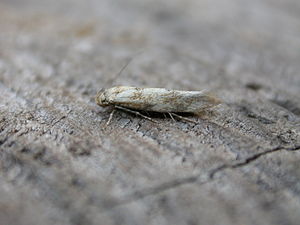Mompha epilobiella
| Mompha epilobiella | ||||||||||||
|---|---|---|---|---|---|---|---|---|---|---|---|---|

Mompha epilobiella |
||||||||||||
| Systematics | ||||||||||||
|
||||||||||||
| Scientific name | ||||||||||||
| Mompha epilobiella | ||||||||||||
| ( Denis & Schiffermüller , 1775) |
Mompha epilobiella is a butterfly ( moth ) fromthe fringed moth family (Momphidae).
features
The moths reach a wingspan of 10 to 13 millimeters. The head is yellowish white and speckled brownish. The thorax is ocher in color. The front wings are also ocher and grayish on the Costa loader. An indistinct yellow spot is on the Costa loader at 3/4 of the forewing length, a similar spot is on the inner corner . Two small clusters of slightly protruding dark brown scales are located at 1/5 of the forewing length and in the middle of the inner wing edge. The hind wings shine gray.
The males differ from the similar species Mompha subbistrigella in the following characteristics : The sacculus is shortened and has a group of small teeth apically. The aedeagus has a hook-shaped cornutus and several straight cornuti.
In females, the 8th tergite is rounded at the rear end. The ductus bursae has a narrow and short posterior and an abruptly enlarged anterior part. Both parts have a conspicuous sclerotized plate with heavily sclerotized edges.
distribution
The distribution area of Mompha epilobiella extends in the north to southern Fennoscandinavia and in the east to Asia Minor , the Caucasus and the submontane areas of Central Asia . The species was probably introduced to the east of North America . It is very common.
biology
The caterpillars develop on shaggy willowherb ( Epilobium hirsutum ), more rarely also on mountain willowherb ( Epilobium montanum ), marsh willowherb ( Epilobium palustre ), narrow-leaved willowherb ( Chamaenerion angustifolium ) and evening primrose species ( Oenothera ). Plants from other families have also been mentioned repeatedly in the literature, such as great fleaweed ( Pulicaria dysenterica ), common purple loosestrife ( Lythrum salicaria ) and common water feast ( Eupatorium cannabinum ). This evidence requires confirmation.
The species forms two, sometimes three generations per year. The first generation caterpillars develop from mid-May to June, those of the second generation from July to early August. They live between spun leaves. Often up to 50 specimens are found on a plant. The young caterpillars are leaf miners or drill into the seed pods at the tip of the shoots. The caterpillars pupate in a white, silky cocoon between the leaves. The moths overwinter. They can be found year-round, but are particularly common in July and August. The moths come to light .
Systematics
The following synonyms are known from the literature:
- Cleodora nebulella Stephens , 1834
- Recurvaria fulvescens Haworth , 1828
- Tinea epilobiella Denis & Schiffermüller , 1775
swell
Individual evidence
- ↑ a b c d J. C. Koster, S. Yu. Sinev: Momphidae, Batrachedridae, Stathmopodidae, Agonoxenidae, Cosmopterigidae, Chrysopeleiidae . In: P. Huemer, O. Karsholt, L. Lyneborg (eds.): Microlepidoptera of Europe . 1st edition. tape 5 . Apollo Books, Stenstrup 2003, ISBN 87-88757-66-8 , pp. 41 (English).
- ↑ Karl Traugott Schütze: The biology of the small butterflies with special consideration of their nutrient plants and times of appearance. Handbook of Microlepidoptera. Caterpillar calendar arranged according to the illustrated German Flora by H. Wagner. Frankfurt am Main, publishing house of the International Entomological Association e. V., 1931, p. 143
- ↑ Guide to the moths of Great Britain and Ireland. Mompha epilobiella. Ian Kimber, accessed November 22, 2011 .
- ↑ Mompha epilobiella in Fauna Europaea. Retrieved November 22, 2011
Web links
- Lepiforum e. V. - Taxonomy and photos
